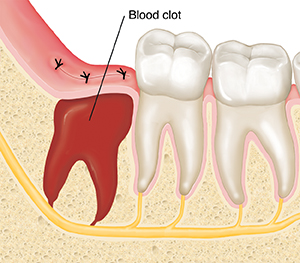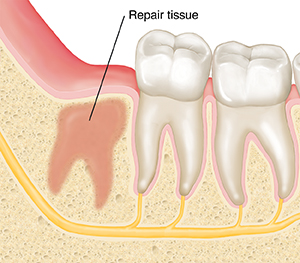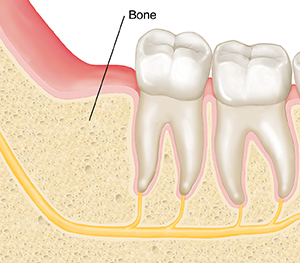Wisdom Teeth Surgery: Your Recovery
After surgery to remove your wisdom teeth, your mouth needs time to heal. Some bleeding is normal on the first day after surgery. You may also see some bruising and swelling on your face for about the first week. To promote faster healing, get enough rest, eat and drink nutritious foods, and take care of the extraction site. Follow any special directions from your surgeon.
The healing process
Healing after wisdom teeth removal takes a few months. First, a blood clot forms in the socket where the wisdom tooth was removed. This blood clot needs to stay in place to protect the bone and nerves. Within a day or 2, the socket starts filling with repair tissue. This lays the foundation for new bone tissue to grow. When new bone tissue fills the socket, healing is complete.
 |
| A few hours after surgery, a blood clot develops to fill the socket. |
 |
| About 3 weeks after surgery, repair tissue has filled the socket. |

After surgery
During the first 1 to 2 days after surgery:
-
Control bleeding. Bite down on the gauze dressing over the extraction site. Use constant pressure. Bleeding should stop within 2 hours. (Some oozing for a few days is normal.)
-
Take medicine as directed. Your surgeon may prescribe pain medicine or may suggest using over-the-counter medicine instead. You may also be prescribed antibiotics to prevent infection.
-
Reduce swelling. Apply an ice pack to your cheek for 10 minutes at a time. Take a break of at least 5 minutes between applications. To make an ice pack, put ice cubes in a plastic bag that seals at the top. Wrap the bag in a clean, thin towel or cloth. Never put ice or an ice pack directly on the skin.
-
Don’t drink hot liquids. Heat may increase swelling or bleeding.
-
Get enough rest. Take it easy for at least 24 hours after surgery. And go to bed early.
-
Drink nutritious liquids. Once bleeding has stopped, try drinking vegetable juice, 100% fruit juice, protein drinks, or milk.
-
Protect the extraction site. To prevent dislodging the blood clot, don’t brush your teeth or rinse your mouth the first day. Don’t smoke or drink through a straw. Suction can dislodge the clot.
Helping your mouth heal
-
Return slowly to your normal diet. Start with soft foods, such as oatmeal, bananas, or mashed potatoes. You can puree fruits and vegetables in a blender. You can eat solid food when directed by your surgeon. Don't chew with the teeth near the extraction site.
-
Brush and floss your teeth gently. Follow directions from your surgeon. They may suggest that you wait until the day after surgery. Then, take care when cleaning around the healing site.
-
Keep the extraction site clean. Follow directions from your surgeon. They may suggest rinsing your mouth after each meal for about a week. Use antiseptic as directed or make a mixture of 1 cup warm water and ½ teaspoon salt. Don't use over-the-counter mouthwash.
Things to avoid
-
Don’t drive while you’re taking prescription pain medicine.
-
Don’t drink alcohol for as long as you’re taking pain medicine.
-
Don’t smoke for at least a week after surgery. This allows faster healing. The longer you keep from smoking, the better. Quitting permanently is best of all.
-
Don’t eat crunchy or sticky foods for at least 2 weeks. This includes foods such as popcorn or caramel. Also, don't drink thick liquids (such as a milk shake) through a straw.
-
Don't rinse your mouth vigorously during the first 24 hours. You may dislodge the blood clot.
When to call your healthcare provider
Call your healthcare provider right away if any of the following occur:
-
The pain gets worse on the day after surgery or can’t be controlled with pain medicine.
-
Bleeding becomes hard to control or comes in spurts.
-
You have chills.
-
You have a fever of 100.4ºF (38ºC) or higher, or as directed by your provider.
-
Swelling around the extraction site gets worse.
-
You have itching, a rash, or other symptoms that may be due to an allergic reaction to your medicine.
-
You have persistent nausea or vomiting.
Online Medical Reviewer:
Jessica Gotwals RN BSN MPH
Online Medical Reviewer:
Michael Kapner MD
Online Medical Reviewer:
Tennille Dozier RN BSN RDMS
Date Last Reviewed:
12/1/2022
© 2000-2025 The StayWell Company, LLC. All rights reserved. This information is not intended as a substitute for professional medical care. Always follow your healthcare professional's instructions.